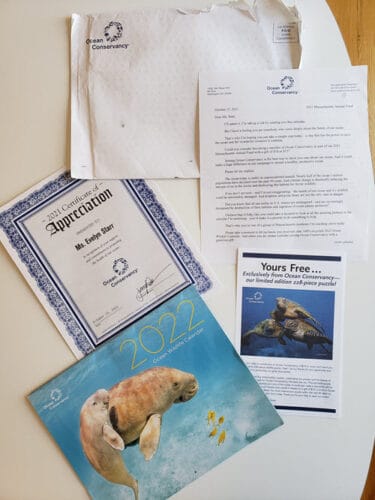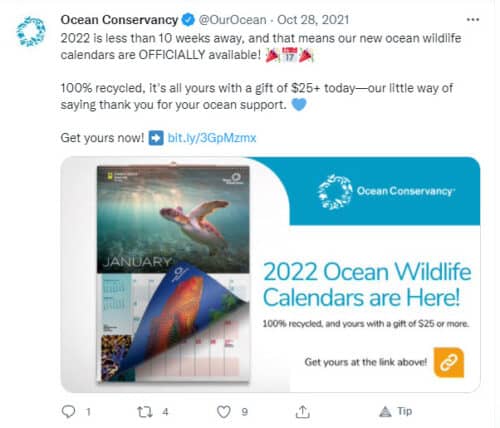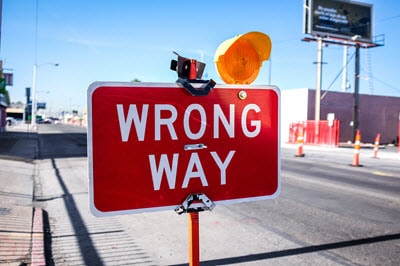Last November 2nd, a thick white envelope from Ocean Conservatory arrived in the mail.
I’d never heard of the organization.
As a family we had donated to a similar organization in the past. I assumed Ocean Conservatory had gotten my name from a shared list.
I smiled to myself thinking this organization had a four-week jump on Giving Tuesday (November 30, 2021). Kudos to them for an early pitch.
Then I opened the envelope.
Inside I found:
- A certificate of appreciation with my name on it
- A letter explaining Ocean Conservancy was taking a risk by sending me a calendar and asking me to confirm receipt and to donate
- A full-size wall calendar (made from 100% recycled paper)
- A response form with a return envelope
- An additional flyer with an offer for a puzzle
- And the usual page of return address stickers (not pictured below)

The package prompted me to think about Ocean Conservancy.
I’m sure the impression it made was not what they were going for.
Marketing Overkill
I have ranted to you before about organizations putting my name on their mailing list without my permission.
That’s not what struck me about this package.
It was So. Much. Paper.
Yes, the calendar was made from 100% recycled paper. But still.
Non-profits often send return address labels or blank greeting cards to take advantage of the “rule of reciprocation.”
This rule refers to humans’ tendency to feel obliged to reciprocate when given a gift. Non-profits hope that their gift will prompt the recipient to donate.
Ocean Conservatory went overboard on this concept. (Pun intended.)
In sending a calendar, a certificate, an offer for a puzzle, and return address labels, they overwhelmed me.
Stoking the Wrong Emotions
I felt surrounded by stuff and wondered how many trees had died for this marketing campaign?
Yikes!
Lest you think I am an ocean hater or have an aquatic aversion, please know I think Ocean Conservancy’s intent is wonderful. Their work is important.
I also get that people love swag.
From their social media posts at the end of October, I can see many in their audience valued the calendar. Ocean Conservancy’s posts asked for a $25 donation upfront to receive one.
That approach makes sense to me.

I’m not picking on them to be mean, just to show their appeal to me backfired.
I wished they had sent a postcard to ask if I wanted that stuff, instead of spending money and tree carnage to create marketing pieces that did not appeal to me.
Instead of motivating me to donate, Ocean Conservancy stoked my forest conservation concerns and poked my aversion to clutter.
According to Jasmin Milak Chua’s Vox article “Why nonprofits give away so much crap,” many donors share my reaction.
How Marketing Misfires Happen
Why would a non-profit send such a massive envelope of stuff to begin with?
I suspect the marketing team at Ocean Conservatory believed in the “rule of reciprocation,” fell in love with this extensive campaign, and never sought feedback from their donor audience.
Or worse, they ignored the feedback they got.
As David Vinjamuri explains, marketing blunders happen “when you try to build your brand by looking at it through the lens of data rather than from the perspective of your consumer.”
Broad-based data and beliefs can be a starting point, but do not constitute solid foundations for specific marketing efforts like product development, packaging design, or ad campaigns.
You need direct consumer feedback not only on your marketing endeavor but also on its impact within the context of your brand.
Without that feedback, you risk committing a marketing blunder that tarnishes your brand’s reputation and customer relationships.
Marketing Blunders Cost Money, Time, and Brand Credibility
Major brands have taken big risks before and lost. Legendary examples include:
Pepsi Co.’s failed Tropicana package change in 2009. Consumers complained the new package was generic-looking, ugly, and difficult to differentiate between varieties.
The company announced they were changing back to the old package just seven weeks after the new one launched.
Neil Campbell, president of Tropicana North America, said, “What we didn’t get was the passion that this very loyal small group of consumers have. That wasn’t something that came out in the research.”
Notice he did not say the research showed consumers loved the package?
I suspect the research was insufficient, because sales declined 20 percent in two months. It takes more than a very small group of loyalists to tank a brand that fast.
Coca Cola’s New Coke launch in 1985. Famous in the marketing insights community, the company never told research participants they planned to take the old Coke away.
They taste-tested the New Coke and old Coke formulas blindly. New Coke scored better according to their spokespeople. But the blind tests gave no indication of customers’ attachment to the original brand.
When Coca-Cola launched New Coke on April 23 and took away the old one, intense protests occurred. On July 11, they brought back the old Coke as Coca Cola Classic.
Bic for Her Pens in 2012. These were pink and purple pens supposedly designed to fit women’s hands.
This one left me speechless. By now you know that’s saying something.
Avoid Blunders with Consumer Listening and Feedback
The big brand blunders above – say that three times fast – indicate that those brands did not know their audience.
They researched their marketing endeavor on a narrow basis or not at all.
To be the brand that dominates your niche and resonates most with your audience, isolated research efforts are not enough.
Your brand needs the context of your audience’s attitudes, views, problems, and preferences to evaluate marketing opportunities.
You need to be listening to your customers and other constituencies on a regular basis.
To propel your brand and avoid marketing blunders:
- Be the bartender of your brand. Get out and among your target audience. Start conversations with customers. Listen to learn about their lives, their challenges, their experiences, and where they get their information.
- Join or handle customer service conversations. A few hours tackling your customers’ issues can give you insights to where they need help and where your brand could improve.
- Listen and interact on social media. It’s easier than ever for customers and prospects to find and follow your brand. You can understand their actual personas instead of fabricating composite ones by seeing what they post and messaging with them.
- Read and respond to your brand’s reviews. Yes, there will be the occasional unfair assessment. But earnest negative reviews offer a chance to improve both performance and your relationship with customers. And positive reviews are rewarding!
- Get feedback on each marketing effort before launch. Having context boosts your chances of designing products, services, and marketing that resonate and delight your audience. You still need to get your customers’ input and feedback on each specific endeavor to ensure your investment builds positive equity for your brand.
My friend Kathryn, who is both a consumer and an editor, wrote to me about a bridal shop in her neighborhood called I Do Weddings. The web address on their window reads: www.idoweddings.com.
What Kathryn sees: wwW.IDOWweddings.com.
The word widow right in the middle. The last thing brides want to think about.
Having someone in their audience proofread or review their sign could have dodged that unfortunate situation. It’s a simple fix: use https://idoweddings.com!
Great brand marketing is not a string of occasional events or moments, but an ongoing conversation.
Listening and conversing with customers will not guarantee your marketing success. But it can go a long way to preventing blunders.
I hope I was the outlier for Ocean Conservatory and that their campaign paid off.
The volume of paper disturbed me so much I sent back the response form in the return envelope with a request to be taken off their list. If I’m not going to donate, at least I can avoid draining their funds.
Have you encountered a mind-boggling marketing blunder?
***
Just for Fun
The Bic for Her product launch may have left me speechless, but others had plenty to say.
Many of the one-star reviews on Amazon give SNL writers a run for their money.
Ellen DeGeneres’ segment on the pens includes her famous rant and what a Bic for Her commercial might look like.
And if marketing train-wrecks are your thing, see how OB tampons marketed their contribution to keeping oceans clean in this OB commercial featuring a talking crab.


I loved your comments about the Ocean Conservatory. I get that stuff all the time. I’m wondering how to stop it. I totally agree, too much junk mail, a waste of paper and (how many trees).
Thanks Joanne. As for stopping the mailings, you could try my tactic of mailing back the response form with a request written on there to be taken on the list. Or you could try calling the organization to make the request.